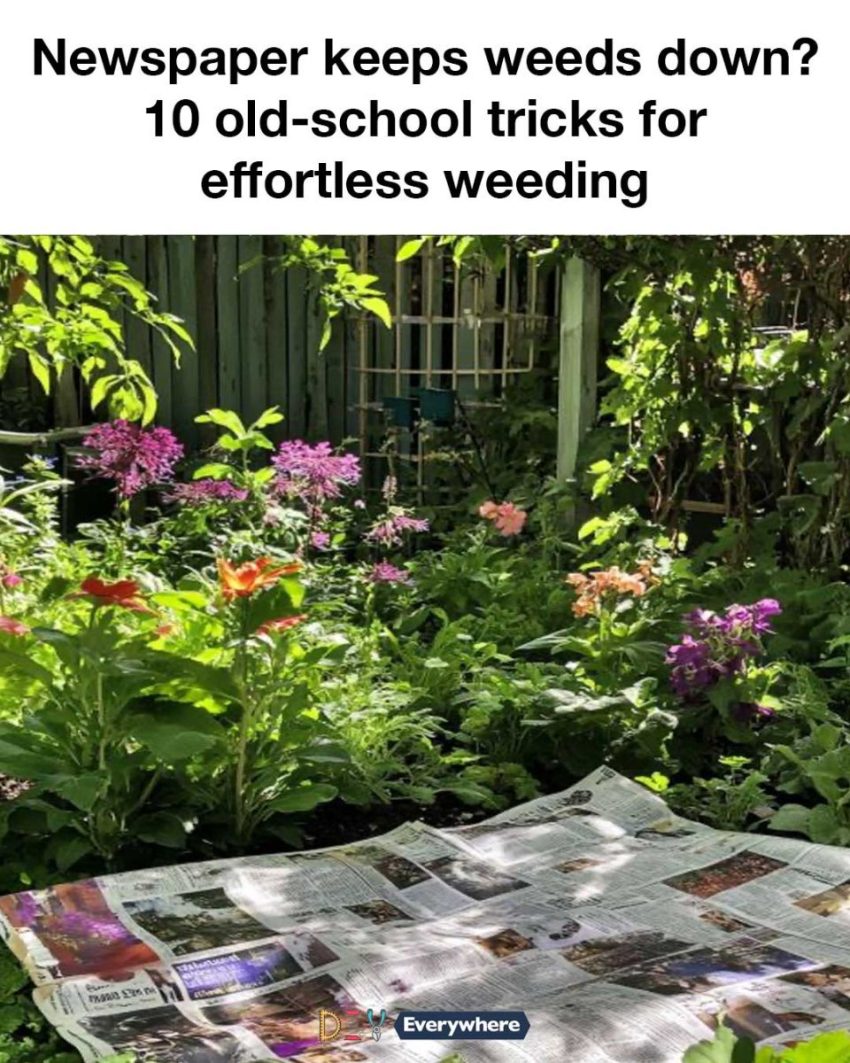ADVERTISEMENT
1. The Newspaper Mulch Method
Using newspaper as a mulch is an effective and eco-friendly way to suppress weeds. Start by laying down a thick layer of newspaper, about 5-10 sheets thick, over the area you want to protect. Be sure to overlap the edges so that no gaps are left for weeds to sneak through. Once the newspaper is in place, water it thoroughly to help it stay in place and begin breaking down.
Cover the newspaper with a layer of organic mulch, such as straw, wood chips, or grass clippings, to improve the appearance and further suppress weeds. The newspaper will block sunlight, preventing weed seeds from germinating, while the mulch on top will add nutrients to the soil as it decomposes. This method not only keeps weeds down but also improves soil quality over time.
2. Vinegar: The Natural Weed Killer
Vinegar is a natural and effective weed killer that can be used to tackle unwanted plants. The acetic acid in vinegar draws moisture out of the weeds, causing them to wither and die. For best results, use a vinegar with at least 5% acetic acid concentration. Simply fill a spray bottle with vinegar and apply it directly to the leaves of the weeds on a sunny day.
Be careful to target only the weeds, as vinegar can also harm your desirable plants. It’s most effective on young, small weeds and may require multiple applications for larger, established weeds. This method is best used for spot treatments rather than large areas.
3. Boiling Water for Instant Results
Boiling water is a simple and immediate way to kill weeds, especially those growing in cracks and crevices of driveways or sidewalks. Carefully pour boiling water directly onto the weeds, ensuring that the water reaches the roots. The intense heat will destroy the plant cells and kill the weeds almost instantly.
This method is highly effective for small areas and hard-to-reach spots but should be used with caution around desirable plants, as it can also damage them. Repeated applications may be necessary for particularly stubborn weeds.
4. Salt: A Simple Solution
Salt is a traditional method for killing weeds, but it should be used sparingly and with caution. Mix a solution of about 1 part salt to 3 parts water and apply it directly to the leaves and base of the weeds. The salt will dehydrate the plants, leading to their demise.
Be mindful that salt can affect soil health, making it inhospitable for future plant growth. It’s best used in areas where you don’t plan to grow anything else, such as driveways or walkways. Rinse the area with water after the weeds have died to minimize soil damage.
5. Corn Gluten Meal as a Pre-Emergent
Corn gluten meal is a natural byproduct of corn processing and can be used as a pre-emergent herbicide. It works by inhibiting seed germination, making it an excellent choice for preventing weeds before they start. Apply corn gluten meal to your garden beds at a rate of about 20 pounds per 1,000 square feet, ideally before weed seeds begin to germinate in early spring.
Water the area lightly after application to activate the gluten meal, but avoid heavy watering, which can wash it away. This method is safe for established plants and can also provide a nitrogen boost to your soil.
6. Hand Weeding with a Twist
Hand weeding is a time-tested method for removing weeds, but it can be made more effective with a few simple tricks. For best results, weed after a rain when the soil is moist and loose, making it easier to pull weeds out by the roots. Use a weeding tool or a small trowel to help loosen the soil around the base of the weed before pulling.
To make the task less daunting, set aside a few minutes each day to tackle a small section of your garden. Regular maintenance will prevent weeds from becoming overwhelming and will keep your garden looking its best.
7. Baking Soda for Cracks and Crevices
Baking soda is another household item that can be used to combat weeds, particularly those growing in cracks and crevices. Sprinkle a generous amount of baking soda directly onto the weeds and into the cracks. The high sodium content will kill the weeds by disrupting their water balance.
This method is most effective for small, isolated areas and should be reapplied as needed. Be cautious when using baking soda near desirable plants, as it can also affect their growth.
8. The Power of Mulching
Mulching is a highly effective way to suppress weeds while also improving soil health. Apply a layer of organic mulch, such as wood chips, straw, or shredded leaves, about 2-4 inches thick over your garden beds. This will block sunlight from reaching weed seeds, preventing them from germinating.
Mulch also helps retain soil moisture, regulate temperature, and add nutrients as it breaks down. Be sure to replenish the mulch layer as needed to maintain its effectiveness throughout the growing season.
9. Flame Weeding for Tough Spots
Flame weeding involves using a propane torch to apply direct heat to weeds, causing them to wilt and die. This method is particularly effective for tough spots like gravel paths or driveways. Pass the flame over the weeds briefly, just enough to cause the plant cells to burst.
Flame weeding is best used on young weeds and should be done with caution to prevent fire hazards. Avoid using this method in dry, windy conditions or near flammable materials.
10. Soap and Water Spray
A simple soap and water spray can be an effective way to kill weeds by breaking down their protective outer coating. Mix a few tablespoons of dish soap with a gallon of water and apply it to the leaves of the weeds using a spray bottle.
This method works best on small, young weeds and may require multiple applications. The soap helps the solution stick to the leaves, increasing its effectiveness. Be careful to avoid spraying desirable plants, as the soap can also damage them.
11. Companion Planting to Deter Weeds
Companion planting involves strategically placing certain plants together to naturally deter weeds and pests. Some plants, like marigolds and nasturtiums, can help suppress weed growth by releasing natural chemicals that inhibit germination.
Additionally, densely planting crops can create a living mulch, shading the soil and preventing weed seeds from receiving the sunlight they need to grow. Experiment with different plant combinations to find what works best for your garden and enjoy the added benefits of increased biodiversity and pest control.


